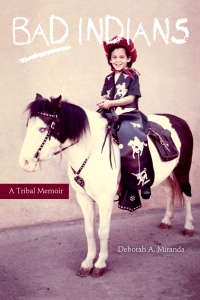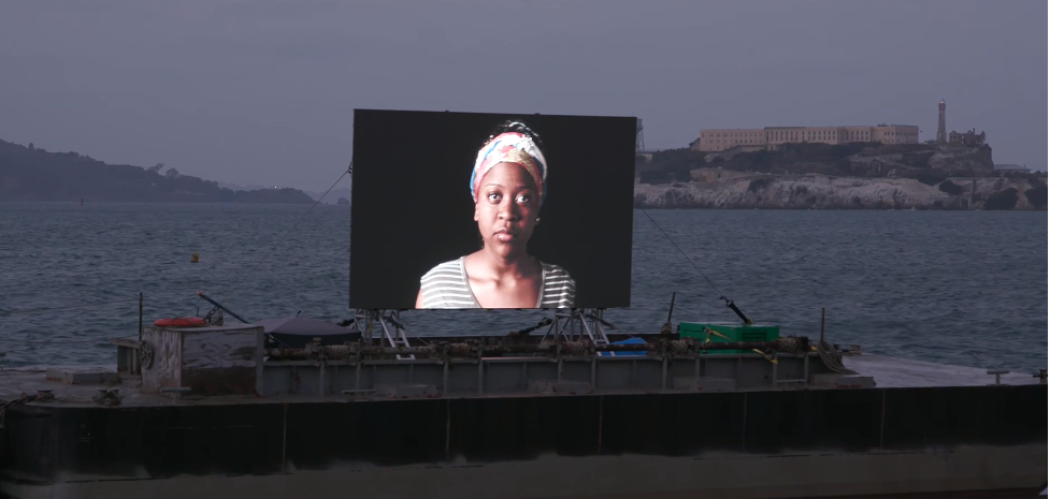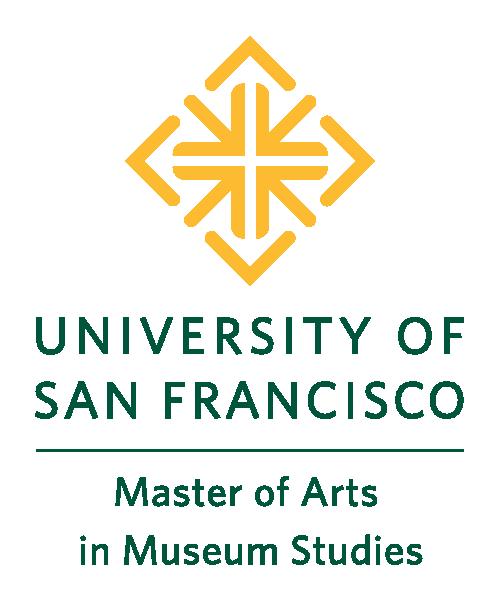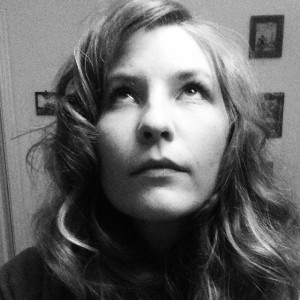by Nicole Meldahl
The best part about being a Museum Studies graduate student is stepping outside your comfort zone within your chosen field, even if you’ve been a museum professional for some time. This is particularly true for students in Professor John Zarobell’s Curatorial Practicum being taught this Fall as an elective course in the University of San Francisco’s museum studies program. This week, our class opens Interwoven: Indigenous Contemporary–the contemporary Native Californian art exhibit we have curated at USF’s Mary and Carter Thacher Gallery.

The curatorial practicum students meeting with Professor John Zarobell to begin the installation process.
Interwoven: Indigenous Contemporary continues a conversation on Indigenous artistry from the Thacher Gallery’s Fall exhibit, Interwoven: Native California Basketry Arts from the Missions Forward. It moves the dialogue forward by presenting a survey of generationally diverse artists who dispel romanticized Native American archetypes and challenge preconceived ideas about Indigenous identity in California. This exhibit could not have been staged at a more perfect time because the personal truths expressed in their work are bold, they are brave, and they are particularly resonant given the often polarizing debate surrounding Father Junipero Serra’s recent canonization by Pope Francis.
 For many of us in the Curatorial Practicum, contemporary art was a foreign language and Native Californian culture a topic last studied seriously in far-away undergraduate history courses. Time has been at a premium in the rushed world of semester-long exhibition curation, but we’ve read Terry Smith’s What Is Contemporary Art and Bad Indians by Deborah Miranda to quickly bring ourselves up to speed. Terry Smith’s work has provided a fantastic overview of how contemporary art is conceived and commodified, but perhaps most relevant to our class is its philosophical discussion of contemporaneity. Smith partially qualifies contemporary artistic intent as a means of synthesizing multiple temporalities within the present, or, in other words, of understanding the “presentness” of the past within contemporary culture. Within this intent, artists deftly exploit concepts of “time, place, mediation, and mood” to question the nature of temporality and create a sense of place in the wake of dislocation (both physical and emotional) in the expression of personal and universal truths.
For many of us in the Curatorial Practicum, contemporary art was a foreign language and Native Californian culture a topic last studied seriously in far-away undergraduate history courses. Time has been at a premium in the rushed world of semester-long exhibition curation, but we’ve read Terry Smith’s What Is Contemporary Art and Bad Indians by Deborah Miranda to quickly bring ourselves up to speed. Terry Smith’s work has provided a fantastic overview of how contemporary art is conceived and commodified, but perhaps most relevant to our class is its philosophical discussion of contemporaneity. Smith partially qualifies contemporary artistic intent as a means of synthesizing multiple temporalities within the present, or, in other words, of understanding the “presentness” of the past within contemporary culture. Within this intent, artists deftly exploit concepts of “time, place, mediation, and mood” to question the nature of temporality and create a sense of place in the wake of dislocation (both physical and emotional) in the expression of personal and universal truths.
 Bad Indians also seeks to reconcile the past within the present but through the lens of memoir. Miranda exposes herself and family to show us the reverberating effects of the Mission System in California, and the disconnect between this brutal history and the way it’s taught to 4th-graders throughout the state. In othering Native Californians, the historical narrative has made “Indians” a thing of the past. However, as we learned from Terry Smith, contemporary art provides a forum for Indigenous artists to landscape the present with personal truths, to carve out an identity within contemporary culture in order to remedy their historic invisibility while respecting traditional modes of artistic creation. The key to this delicate balance is context. As Miranda states, “we must think of ourselves as a mosaic, human beings constructed of multiple sources of beauty, pieces that alone are merely incomplete but which, when set into a new design together, complement the shards around us, bring wholeness to the world and ourselves.”
Bad Indians also seeks to reconcile the past within the present but through the lens of memoir. Miranda exposes herself and family to show us the reverberating effects of the Mission System in California, and the disconnect between this brutal history and the way it’s taught to 4th-graders throughout the state. In othering Native Californians, the historical narrative has made “Indians” a thing of the past. However, as we learned from Terry Smith, contemporary art provides a forum for Indigenous artists to landscape the present with personal truths, to carve out an identity within contemporary culture in order to remedy their historic invisibility while respecting traditional modes of artistic creation. The key to this delicate balance is context. As Miranda states, “we must think of ourselves as a mosaic, human beings constructed of multiple sources of beauty, pieces that alone are merely incomplete but which, when set into a new design together, complement the shards around us, bring wholeness to the world and ourselves.”
After reading these books, our mission as a class transformed from curating an art exhibit to facilitating a mosaic of contemporary art. We were broken up into three groups–Marketing & PR, Education, and Installation–in order to divide and conquer, and quickly began drafting press releases, visualizing the gallery, and contacting artists for their input on labels. We were even able to squeeze in quick visits to the studios of exhibiting artists Katie Dorame and Lewis deSoto, who were patiently gracious with their time.
The world of contemporary art curation appears to be beautifully controlled chaos at times–especially when you have less than a semester to do it! The learning curve has been huge, but Professor Zarobell has paid us the compliment of freedom to tackle our assignments in our own ways. This exhibition is not only teaching us the art of curation, but also the art of approaching artists and their culture with respect, and we are so excited to see the mosaic come together.
Interwoven: Indigenous Contemporary opens on November 16, 2015 and will remain open to the public until February 14, 2016. Admission is free of charge and hours for the Thacher Gallery, located in the Gleeson Library-Geschke Center, are noon to 6p.m. daily. We are also planning several programs in conjunction with the exhibition, including:
- On November 18, 2015, opening festivities will include a student-moderated panel discussion with exhibiting artists Hulleah Tsinhnahjinnie, Katie Dorame, and Rye Purvis in the McLaren Conference Center Room 251, from 5pm – 6pm. Reception to follow will include a spoken-word blessing by Kanyon Sayers-Roods, and will be held from 6pm – 7:30pm in the Thacher Gallery, Gleeson Library.
- Community Day will take place on the lawn outside the Gleeson Library-Geschke Center from noon to 3:00pm on November 21, 2015. Exhibiting artist Geri Montano will lead a family-friendly arti activity, and Tyler Hummingbird Peyron, will host a poetry/spoken word workshop.
- Closing Ceremonies will begin on Thursday, February 11th, 2016 at 5:00 p.m. in the Thacher Gallery and will feature exhibiting artist James Luna.
For more information on USF’s Museum Studies program, click here.




